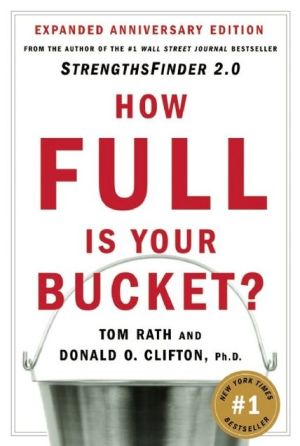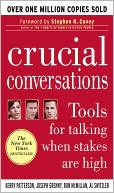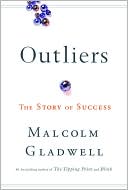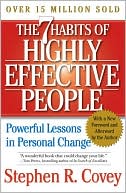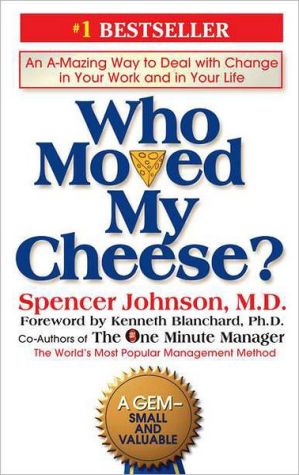How Full Is Your Bucket?: Expanded Anniversary Edition
How did you feel after your last interaction with another person? Did that person — your spouse, best friend, coworker, or even a stranger — "fill your bucket" by making you feel more positive? Or did that person "dip from your bucket," leaving you more negative than before? The number one New York Times and number one Business Week bestseller, How Full Is Your Bucket? reveals how even the briefest interactions affect your relationships, productivity, health, and longevity. Organized around a...
Search in google:
Organized around a simple metaphor of a dipper and a bucket, the #1 New York Times bestseller How Full is Your Bucket? shows how even the smallest interactions we have with others every day profoundly affect our relationships, productivity, health, and longevity. Co-author Donald O. Clifton studied the effects of positive and negative emotions for half a century, and he and his colleagues interviewed millions of people around the world. Their discoveries contributed to the emergence of an entirely new field: Positive Psychology. These same discoveries are at the heart of How Full is Your Bucket? Clifton, who also coauthored the bestseller Now, Discover Your Strengths, penned How Full is Your Bucket? with grandson Tom Rath. Written in an engaging, conversational style, their book includes colorful stories, 5 strategies for increasing positive emotions, and features an online test that measures readers' Positive Impact. How Full is Your Bucket? is a quick, breezy read. It will immediately help readers boost the amount of positive emotions in their lives, and in the lives of everyone around them. The book is sure to inspire lasting changes in all who read it, and has all the makings of a timeless classic. Selling Power magazine A bucketful of miracles . . . Clifton and Rath offer a prescription for reversing the trend toward negativity currently endemic to the American workplace . . . The lessons contained in How Full Is Your Bucket? provide tangible, actionable steps to help turn your workplace into a bustling bastion of positivity and productivity.
\ Ladies' Home JournalKindness really is contagious.\ \ \ \ \ USA TodayFor all the veneer of easygoing pleasantry, this is serious business.\ \ \ The Oprah Magazine O, The Oprah Magazine(Tom Rath and Don Clifton) drew on Gallup research and millions of interviews to argue that this positive give-and-take leads to solid marriages, higher worker satisfaction and productivity, and a happier world.\ \ \ \ \ Entrepreneur magazine50 years of research . . . reveal how positive reinforcement can powerfully boost productivity, satisfaction, and stability in all kinds of organizations. Though brief, it's highly specific.\ \ \ \ \ Selling Power magazineA bucketful of miracles . . . Clifton and Rath offer a prescription for reversing the trend toward negativity currently endemic to the American workplace . . . The lessons contained in How Full Is Your Bucket? provide tangible, actionable steps to help turn your workplace into a bustling bastion of positivity and productivity.\ \ \ \ \ People Management magazineA well-researched, strong, and compelling case for improving self-esteem, better relationships, and health . . . this book is a short, sharp, 'how-to' guide.\ \ \ \ \ Leadership WiredClifton and Rath paint a compelling picture of the good things that happen when people are encouraged, recognized, and praised regularly, as well as the emotional, mental, and sometimes even physical devastation that can occur in the absence of such positive encounters . . . Leaders who want to eliminate or avoid this kind of destruction should make How Full Is Your Bucket? required reading for themselves and their people.\ \ \ \ \ Publishers WeeklyIn this brief but significant book, the authors, a grandfather-grandson team, explore how using positive psychology in everyday interactions can dramatically change our lives. Clifton (coauthor of Now, Discover Your Strengths) and Rath suggest that we all have a bucket within us that needs to be filled with positive experiences, such as recognition or praise. When we're negative toward others, we use a dipper to remove from their buckets and diminish their positive outlook. When we treat others in a positive manner, we fill not only their buckets but ours as well. The authors illustrate how this principle works in the areas of business and management, marriage and other personal relationships and in parenting through studies covering a 40-year span, many in association with the Gallup Poll. While acknowledging that most lives have their share of misfortune, the authors also make clear that how misfortune affects individuals depends largely on their level of positive energy and confidence. The authors also underscore that our human interactions provide most of the joys or disappointments we receive from life. The book comes with a unique access code to www.bucketbook.com, which offers a positive impact assessment and drop-shaped note cards that can be used to give praise and recognition to others. 100,000 first printing. (Sept.) Copyright 2004 Reed Business Information.\ \ \ \ \ Soundview Executive Book SummariesPositive Strategies For Work and Life\ Donald Clifton, cited by the American Psychological Association as the grandfather of Positive Psychology, once discovered that our lives are shaped by our interactions with others. A long conversation with a friend or a short interaction with a stranger both make a difference, sometimes positive, sometimes negative. Although these interactions might seem to be ineffectual, Clifton believed that they accumulate and profoundly affect our lives. Before his death from cancer in September 2003, he and his grandson, Tom Rath, wrote How Full Is Your Bucket? to help people focus on the positive in their lives. \ Clifton had a theory he created in the 1960s that was based on a simple metaphor of a "dipper" and a "bucket." According to this theory, each of us has an invisible bucket. The authors write, "It is constantly emptied or filled, depending on what others say or do to us. When our bucket is full, we feel great. When it's empty, we feel awful."\ Positive and Negative Emotions\ Clifton's theory says that each of us has an invisible dipper that we can either use to fill other people's buckets with positive emotions by saying or doing things that increase their positive emotions, or dipping from others' buckets by saying or doing things that decrease their positive emotions. The theory also explains that when we fill others' buckets, we also fill our own, and likewise, when we dip from others' buckets, we diminish ourselves. A full bucket gives us a positive outlook and an empty bucket poisons our outlook. We make the choice every moment of every day whether we fill one another's buckets, or dip from them. These choices profoundly affect our relationships, productivity, health and happiness, the authors write.\ Moved by horrifying tales of the psychological torture of American prisoners of the Korean War - where there was a 38 percent POW death rate -Clifton and his colleagues in the 1960s wondered: If people can be destroyed by unrelenting negative reinforcement, can they be uplifted and inspired to a greater degree by similar levels of positivity?\ While most of us will never endure the kind of psychological torture that the American POWs suffered during the Korean War, the authors write, we all experience positive and negative interactions every day that influence how we feel and behave. Even undramatic interactions affect us, they add, and "positive experiences or 'bucket filling' can be even more powerful."\ Recognition and Praise\ While working for The Gallup Organization, the authors surveyed more than 4 million employees worldwide on this topic, including more than 10,000 business units and more than 30 industries. Their studies led them to discover that individuals who receive regular recognition and praise:\ \ increase their individual productivity\ are more likely to stay with their organization\ receive higher loyalty and satisfaction scores from customers\ have better safety records and fewer accidents on the job\ \ \ \ \ Great recognition and praise can transform a workplace, the authors write. Their studies show that organizational leaders who share positive emotions have work groups with a more positive mood, enhanced job satisfaction, greater engagement, and improved group performance.\ Not Enough Appreciation\ According to the authors, the majority of us don't give or receive enough praise. As a result, we are much less productive and engaged in our jobs. According to the U.S. Department of Labor, the number-one reason people leave their jobs is because they "do not feel appreciated."\ The authors write that another study of 4,583 call center representatives from a major telecommunications company revealed that three service representatives scared off every single customer they spoke with in a given day - for good. The authors point out that the company would have been better off paying those three people to stay home.\ How Full Is Your Bucket explains how daily bucket filling can be used to enhance life at work and at home while providing research that demonstrates its value.\ Why We Like This Book\ How Full Is Your Bucket offers readers the numbers and statistics that prove what many have suspected but could never quantify: Motivation begins with praise and recognition. Helping to move people closer to their co-workers, family and friends, the authors offer the scientific and anecdotal evidence to show how simple appreciation can be turned into a business plan that makes people more productive, satisfies customers, and helps others live healthier, happier and longer lives. Copyright © 2004 Soundview Executive Book Summaries\ \ \
